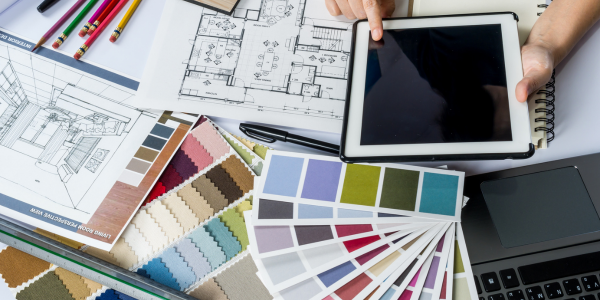Designing your dream home is an exciting journey, but it comes with decisions that can significantly impact the outcome. In this blog post, we’ll explore three popular approaches to home design: the DIY route, hiring a traditional on-site designer, and opting for e-design services. Each has its pros and cons, so let’s weigh them to help you make an informed choice for your next project.
DIY Home Design
Do it yourself method of home design means that you do all the work yourself. You will choose and put together a design concept, shop for all the furniture, paint walls, and decorate your home by yourself. You can shop wherever you want: online, at local designer stores, thrift stores, garage sales, and Facebook marketplace.
Pros:
- Cost Savings: DIY design can save you money on professional fees.
- Full Creative Control: You have the freedom to design your space exactly as you envision it.
- Flexible Timeline: Work at your own pace and make changes as you go.
- Personal Satisfaction: Achieving a personal touch and a sense of accomplishment.
Cons:
- Lack of Expertise: Limited knowledge of design principles and trends may lead to suboptimal results.
- Time-Consuming: Designing, sourcing, and executing can be time-intensive.
- Potential Mistakes: Errors in layout, color choices, or materials can be costly to correct.
- Limited Resources: May not have access to industry contacts, discounts, or exclusive materials.
Traditional On-Site Designer
The traditional on-site designer will work with you on the design concept. The designer will shop for all the furniture and other things needed. She can go shopping in various places. She will also work with contractors who take care of painting walls and other labor. You will get the end results without any hard work.
Pros:
- Professional Expertise: Designers bring knowledge of design principles, space planning, and industry trends.
- Customization: Tailored solutions based on your preferences and lifestyle.
- Access to Resources: Designers often have industry connections and can source unique materials.
- Project Management: They handle the logistics and coordination, reducing your stress.
Cons:
- Higher Cost: Professional fees, furnishings, and materials can make it more expensive. Traditional designer’s fees can start from 3000 dollars.
- Design Not Always Aligned: Your tastes and the designer’s vision may not align perfectly.
- Less Control: You have to rely on the designer’s decisions and may not have the final say.
- Timeline Dependency: Delays may occur due to scheduling and unforeseen issues.
E-Design Services
You can work on your design concept with designers all over the world through the Internet. The designer works on floor plan layouts, makes easily changeable design concepts, does all the furniture shopping online, and gives professional advice. Shopping is done only in online stores.
Pros:
- Affordability: Generally more cost-effective than traditional designers. E-designers complete package fees start from 200 dollars. It is possible to find even cheaper service providers.
- Remote Access: Access design services from anywhere, regardless of your location.
- Quick Turnaround: Faster design process compared to traditional methods.
- Customized Packages: Choose the level of service that fits your needs and budget.
Cons:
- Limited Face-to-Face Interaction: Less personal connection with the designer.
- DIY Execution: You are responsible for implementing the design plan.
- Quality Varies: Quality and style of e-design services may vary between providers.
- Communication Challenges: Clear communication through digital means is essential.

In the end, the choice between DIY, traditional on-site designers, and e-design services depends on your budget, timeline, expertise, and preferences. Each approach has its advantages and disadvantages. If you’re confident in your design abilities and have the time, DIY can be rewarding. Traditional designers offer expertise and personalized solutions but come at a higher cost. E-design services provide a middle ground, offering convenience and cost savings, but require a DIY approach.
